Wound Synchronous Machine Sensorless Control Based on Signal Injection into the Rotor Winding
Abstract
1. Introduction
2. Modeling of a WSM
2.1. WSM Voltage Model
2.2. Incremental Inductance Calculations
3. High-Frequency Model of a WSM
4. Position Estimation Using Signal Injection into the Rotor Winding
4.1. The Analysis of Cross-Coupling Offset Angle
4.2. The Compensation Method for Cross-Coupling Offset Angle
5. Performance Comparison between Rotor and Stator Injection
6. Experimental Results
7. Discussion
Author Contributions
Funding
Conflicts of Interest
Abbreviations
| d and q-axes voltage in the synchronous frame | |
| , | d and q-axes current in the synchronous frame |
| Field current | |
| , , | Phase a, b, c stator flux linkage |
| , | d and q-axes stator flux linkage in the synchronous frame |
| Stator winding resistance | |
| , | d and q-axes self-inductance |
| , | d and q-axes cross-coupling inductance |
| Mutual inductance between d-axis and field coil | |
| Cross-coupling inductance between q-axis and field coil | |
| Leakage inductance of stator | |
| Leakage inductance of field | |
| Rotor flux angle | |
| Estimation rotor flux angle | |
| Estimation rotor flux angle error | |
| Electrical speed and mechanical speed | |
| Angular speed of the carrier signal | |
| Angle offset caused by the cross-coupling | |
| Compensation for angle offset | |
| The input of the PLL | |
| T | Shaft torque |
| WSM | Wound Synchronous Machine |
| EV | Electrical vehicles |
| HEV | Hybrid EVs |
| PMSMs | Permanent-magnet synchronous motors |
| Nd | Neodymium |
| Dy | Dysprosium |
| EMF | Electromotive force |
| MTPA | Maximum torque per ampere |
| FEM | Finite-element method |
| LPF | Low pass filter |
| BPF | Band-pass filter |
References
- Santiago, J.D.; Bernhoff, H.; Ekergard, B.; Eriksson, S.; Ferhatovic, S.; Waters, R.; Leijon, M. Electrical Motor Drivelines in Commercial All-Electric Vehicles: A Review. IEEE Trans. Veh. Technol. 2013, 61, 475–484. [Google Scholar] [CrossRef]
- Kim, Y.; Nam, K. Copper-Loss-Minimizing Field Current Control Scheme for Wound Synchronous Machines. IEEE Trans. Power Electron. 2017, 32, 1335–1345. [Google Scholar] [CrossRef]
- Friedrich, G.; Girardin, A. Integrated starter generator. IEEE Trans. Ind. Appl. Mag. 2009, 15, 26–34. [Google Scholar] [CrossRef]
- Wang, Y.; Wang, X.; Xie, W.; Dou, M. Full-Speed Range Encoderless Control for Salient-Pole PMSM with a Novel Full-Order SMO. Energies 2018, 11, 2423. [Google Scholar] [CrossRef]
- Morimoto, S.; Kawamoto, K.; Sanada, M.; Takeda, Y. Sensorless control strategy for salient-pole PMSM based on extended EMF in rotating reference frame. IEEE Trans. Ind. Appl. 2002, 38, 1054–1061. [Google Scholar] [CrossRef]
- Chen, G.-R.; Yang, S.-C.; Hsu, Y.-L.; Li, K. Position and Speed Estimation of Permanent Magnet Machine Sensorless Drive at High Speed Using an Improved Phase-Locked Loop. Energies 2017, 10, 1571. [Google Scholar] [CrossRef]
- Wang, M.-S.; Tsai, T.-M. Sliding Mode and Neural Network Control of Sensorless PMSM Controlled System for Power Consumption and Performance Improvement. Energies 2017, 10, 1780. [Google Scholar] [CrossRef]
- Genduso, F.; Miceli, R.; Rando, C.; Galluzzo, G.R. Back EMF Sensorless-Control Algorithm for High-Dynamic Performance PMSM. IEEE Trans. Ind. Electron. 2010, 57, 2092–2100. [Google Scholar] [CrossRef]
- Lee, J.; Hong, J.; Nam, K.; Ortega, R.; Praly, L.; Astolfi, A. Sensorless Control of Surface-Mount Permanent-Magnet Synchronous Motors Based on a Nonlinear Observer. IEEE Trans. Power Electron. 2010, 25, 290–297. [Google Scholar]
- Choi, J.; Nam, K.; Bobtsov, A.A.; Pyrkin, A.; Ortega, R. Robust Adaptive Sensorless Control for Permanent-Magnet Synchronous Motors. IEEE Trans. Power Electron. 2017, 32, 3989–3997. [Google Scholar] [CrossRef]
- Koteich, M.; Maloum, A.; Duc, G.; Sandou, G. Observability analysis of sensorless synchronous machine drives. In Proceedings of the 2015 European Control Conference (ECC), Linz, Austria, 15–17 July 2015; pp. 3560–3565. [Google Scholar]
- Tian, L.; Zhao, J.; Sun, J. Sensorless Control of Interior Permanent Magnet Synchronous Motor in Low-Speed Region Using Novel Adaptive Filter. Energies 2016, 9, 1084. [Google Scholar] [CrossRef]
- Gabriel, F.; De Belie, F.; Neyt, X.; Lataire, P. High-Frequency Issues Using Rotating Voltage Injections Intended For Position Self-Sensing. IEEE Trans. Ind. Electron. 2013, 60, 5447–5457. [Google Scholar] [CrossRef]
- Wu, X.; Wang, H.; Huang, S.; Huang, K.; Wang, L. Sensorless Speed Control with Initial Rotor Position Estimation for Surface Mounted Permanent Magnet Synchronous Motor Drive in Electric Vehicles. Energies 2015, 8, 11030–11046. [Google Scholar] [CrossRef]
- Gong, L.M.; Zhu, Z.Q. Robust Initial Rotor Position Estimation of Permanent-Magnet Brushless AC Machines With Carrier-Signal-Injection-Based Sensorless Control. Trans. Ind. Appl. 2013, 49, 2602–2609. [Google Scholar] [CrossRef]
- Li, Y.; Zhu, Z.Q.; Howe, D.; Bingham, C.M. Modeling of Cross-Coupling Magnetic Saturation in Signal-Injection-Based Sensorless Control of Permanent-Magnet Brushless AC Motors. IEEE Trans. Mag. 2007, 43, 2552–2554. [Google Scholar] [CrossRef]
- Zhu, Z.Q.; Gong, L.M. Investigation of Effectiveness of Sensorless Operation in Carrier-Signal-Injection- Based Sensorless-Control Methods. IEEE Trans. Ind. Electron. 2011, 58, 3431–3439. [Google Scholar] [CrossRef]
- Li, Y.; Zhu, Z.Q.; Howe, D.; Bingham, C.M.; Stone, D.A. Improved Rotor-Position Estimation by Signal Injection in Brushless AC Motors, Accounting for Cross-Coupling Magnetic Saturation. IEEE Trans. Ind. Appl. 2009, 44, 1843–1850. [Google Scholar] [CrossRef]
- Sergeant, P.; De Belie, J.; Melkebeek, J. Rotor Geometry Design of Interior PMSMs With and Without Flux Barriers for More Accurate Sensorless Control. IEEE Trans. Ind. Electron. 2012, 59, 2457–2465. [Google Scholar] [CrossRef]
- Li, S.; Ge, Q.; Wang, X.; Li, Y. Implementation of Sensorless Control with Improved Flux Integrator for Wound Field Synchronous Motor. In Proceedings of the 2007 2nd IEEE Conference on Industrial Electronics and Applications, Harbin, China, 23–25 May 2007; Volume 59, pp. 1526–1530. [Google Scholar]
- Maalouf, A.; Ballois, S.L.; Idekhajine, L.; Monmasson, E.; Midy, J.; Biais, F. Sensorless Control of Brushless Exciter Synchronous Starter Generator Using Extended Kalman Filter. In Proceedings of the 2009 35th Annual Conference of IEEE Industrial Electronics, Porto, Portugal, 3–5 November 2009; Volume 59, pp. 2581–2586. [Google Scholar]
- Boldea, I.; Andreescu, G.D.; Rossi, C. Active Flux Based Motion-Sensorless Vector Control of DC-Excited Synchronous Machines. In Proceedings of the 2009 IEEE Energy Conversion Congress and Exposition, San Jose, CA, USA, 20–24 September 2009; pp. 2496–2503. [Google Scholar]
- Jain, A.K.; Ranganathan, V.T. Modeling and Field Oriented Control of Salient Pole Wound Field Synchronous Machine in Stator Flux Coordinates. IEEE Trans. Ind. Electron. 2011, 58, 960–970. [Google Scholar] [CrossRef]
- Griffo, A.; Drury, D.; Sawata, T.; Mellor, P.H. Sensorless starting of a wound-field synchronous starter/generator for aerospace applications. IEEE Trans. Ind. Electron. 2012, 59, 3579–3587. [Google Scholar] [CrossRef]
- Rambetius, A.; Ebersberger, S.; Seilmeier, M.; Piepenbreier, B. Carrier Signal Based Sensorless Control of Electrically Excited Synchronous Machines at Standstill and Low Speed Using The Rotor Winding as a receiver. In Proceedings of the 2013 15th European Conference on Power Electronics and Applications (EPE), Lille, France, 2–6 September 2013; pp. 1–10. [Google Scholar]
- Deng, X.; Wang, L.; Zhang, J.; Ma, Z. Rotor Position Detection of Synchronous Motor Based on High-frequency Signal Injection into the Rotor. In Proceedings of the 2011 Third International Conference on Measuring Technology and Mechatronics Automation, Shangshai, China, 6–7 January 2011; pp. 195–198. [Google Scholar]
- Zhou, Y.; Long, S. Sensorless Direct Torque Control for Electrically Excited Synchronous Motor Based on Injecting High-Frequency Ripple Current Into Rotor Winding. IEEE Trans. Energy Convers. 2015, 30, 246–253. [Google Scholar] [CrossRef]
- Rambetius, A.; Piepenbreier, B. Comparison of carrier signal based approaches for sensorless wound rotor synchronous machines. In Proceedings of the International Symposium on Power Electronics, Electrical Drives, Automation and Motion, Schia, Italy, 18–20 June 2014; pp. 1152–1159. [Google Scholar]
- Rambetius, A.; Piepenbreier, B. Sensorless control of wound rotor synchronous machines using the switching of the rotor chopper as a carrier signal. In Proceedings of the International Symposium on Sensorless Control for Electrical Drives and Predictive Control of Electrical Drives and Power Electronics, Munich, Germany, 17–19 October 2013; pp. 1–8. [Google Scholar]
- Choi, J.; Jeong, I.; Jung, S.; Nam, K. Sensorless Control for Electrically Energized Synchronous Motor Based on Signal Injection to Field Winding. In Proceedings of the IECON2013—39th Annual Conference of the IEEE Industrial Electronics Society, Vienna, Austria, 10–13 November 2013; pp. 3120–3129. [Google Scholar]
- Selmon, G.R. Electric Machines and Drives; Addison Welsley: Boston, MA, USA, 1992; ISBN 0-201-57885-9. [Google Scholar]
- Stumberger, B.; Stumberger, G.; Dolinar, D.; Hamler, A.; Trlep, M. Evaluation of Saturation and Cross-Magnetization Effects in Interior Permanent-Magnet Synchronous Motor. IEEE Trans. Ind. Appl. 2009, 48, 1576–1587. [Google Scholar]
- Nam, K.H. AC Motor Control and Electric Vehicle Application, 1st ed.; CRC Press: Boca Raton, FL, USA, 2010; ISBN 978-1-49-81963-0. [Google Scholar]
- Garcia, P.; Briz, F.; Degner, M.W.; Diaz-Reigosa, D. Accuracy, Bandwidth, and Stability Limits of Carrier-Signal-Injection-Based Sensorless Control Methods. IEEE Trans. Ind. Appl. 2009, 43, 990–1000. [Google Scholar] [CrossRef]
- De Kock, H.W.; Kamper, M.J.; Kennel, R.M. Anisotropy Comparison of Reluctance and PM Synchronous Machines for Position Sensorless Control Using HF Carrier Injection. IEEE Trans. Power Electron. 2009, 24, 1905–1913. [Google Scholar] [CrossRef]
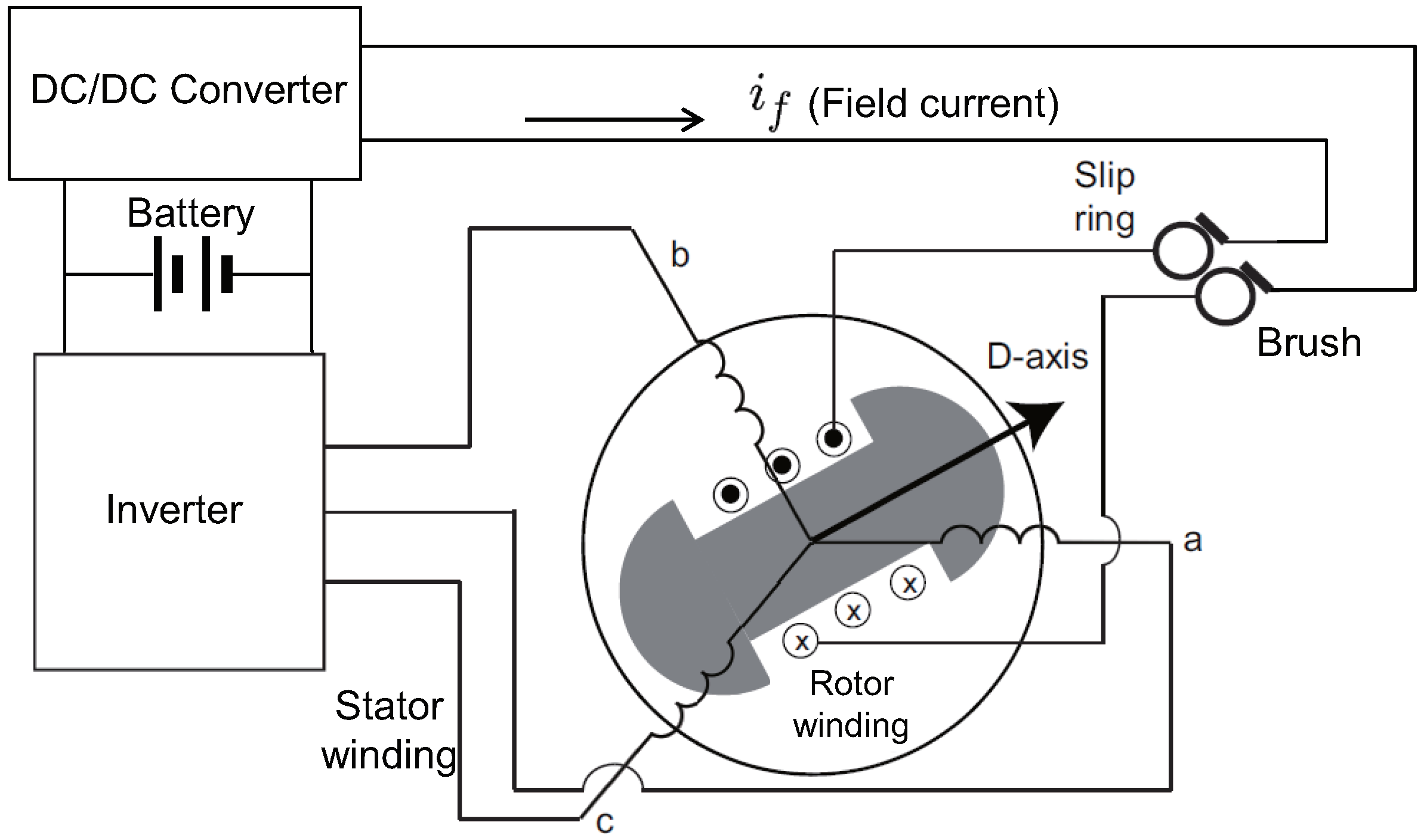

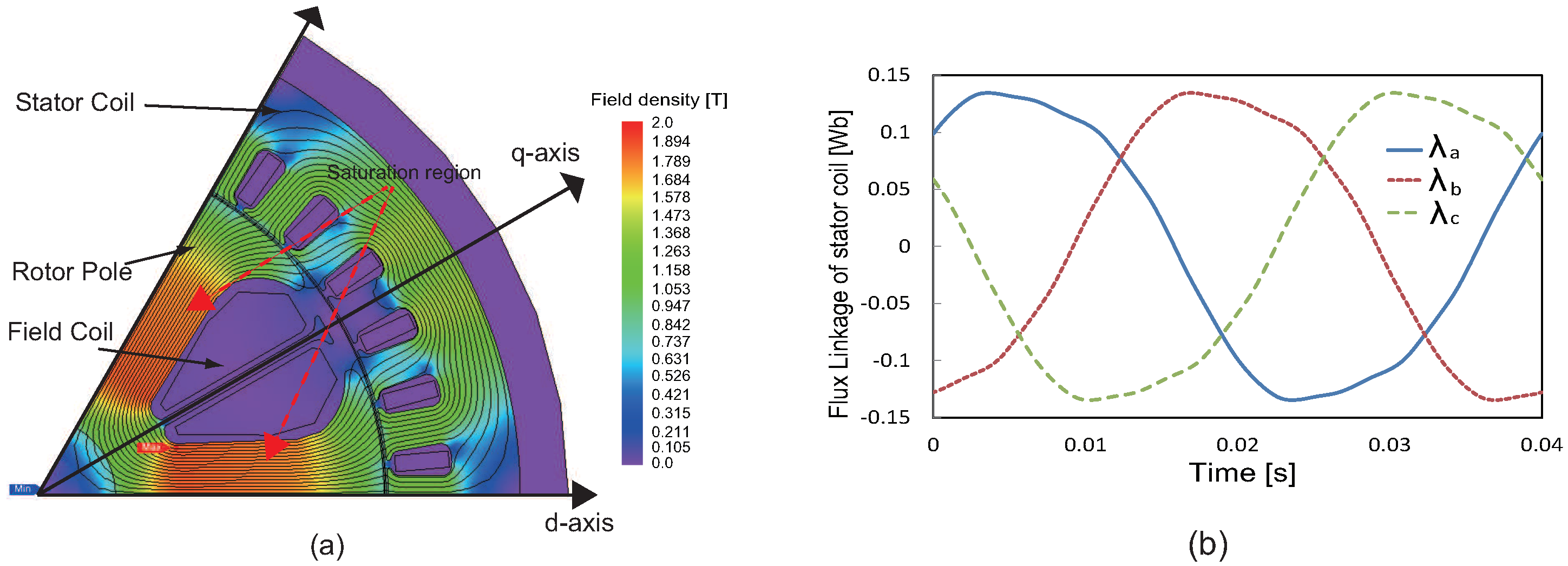
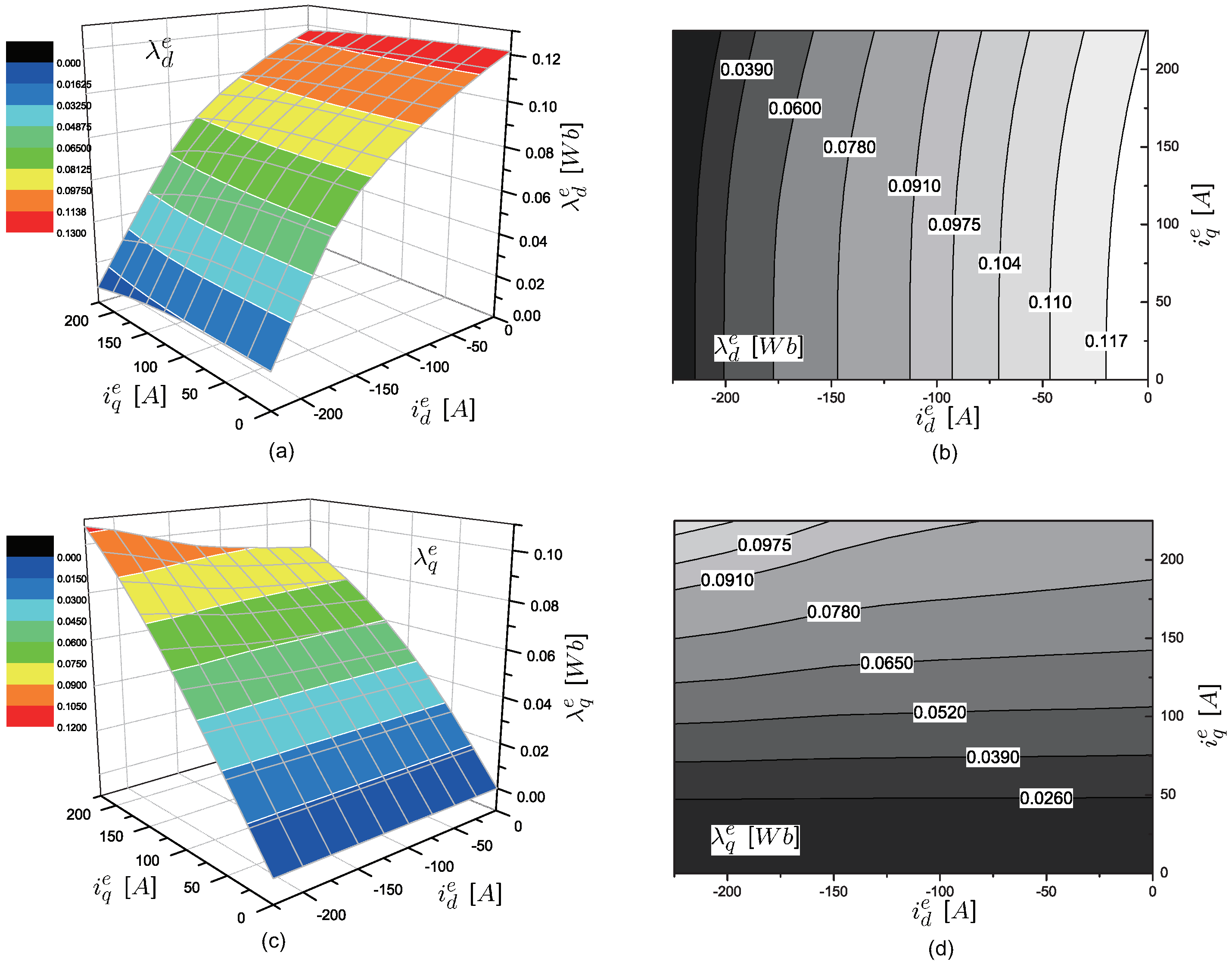
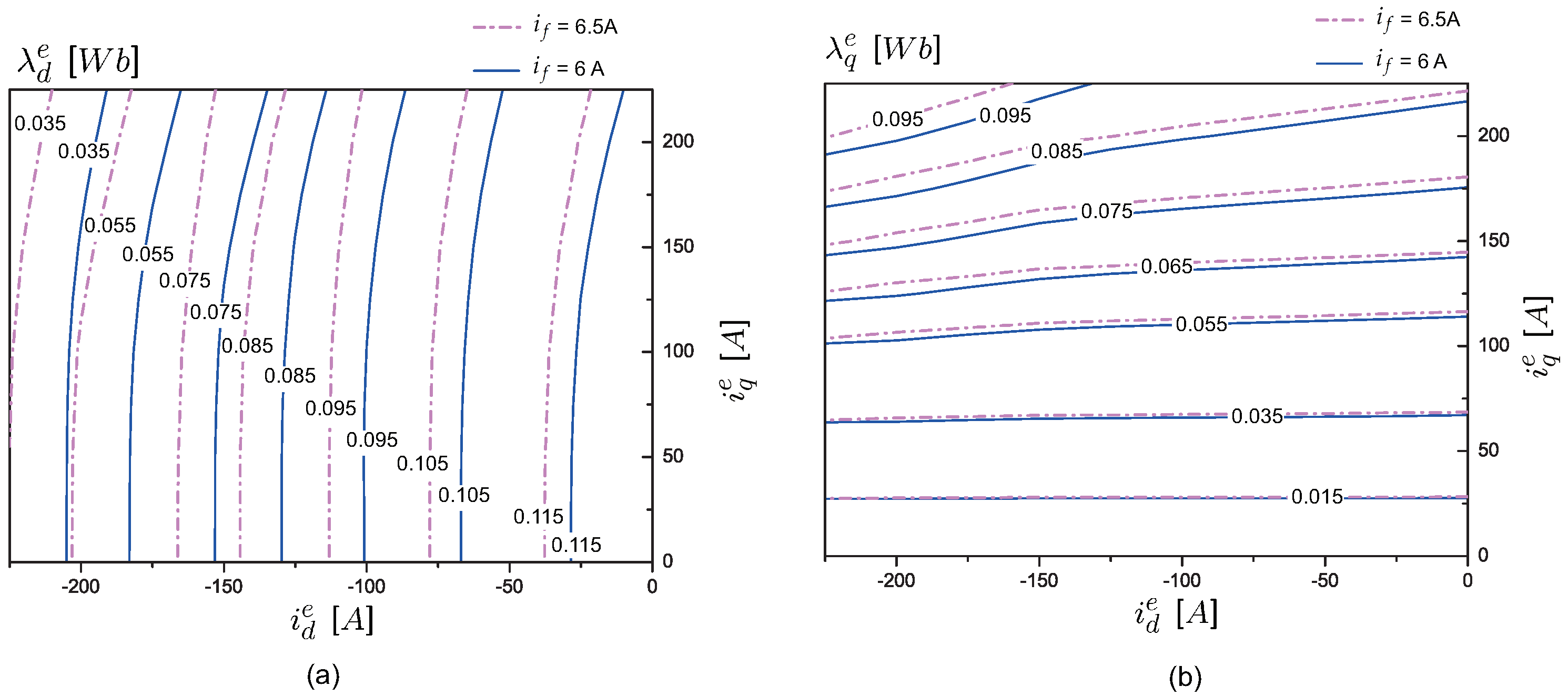
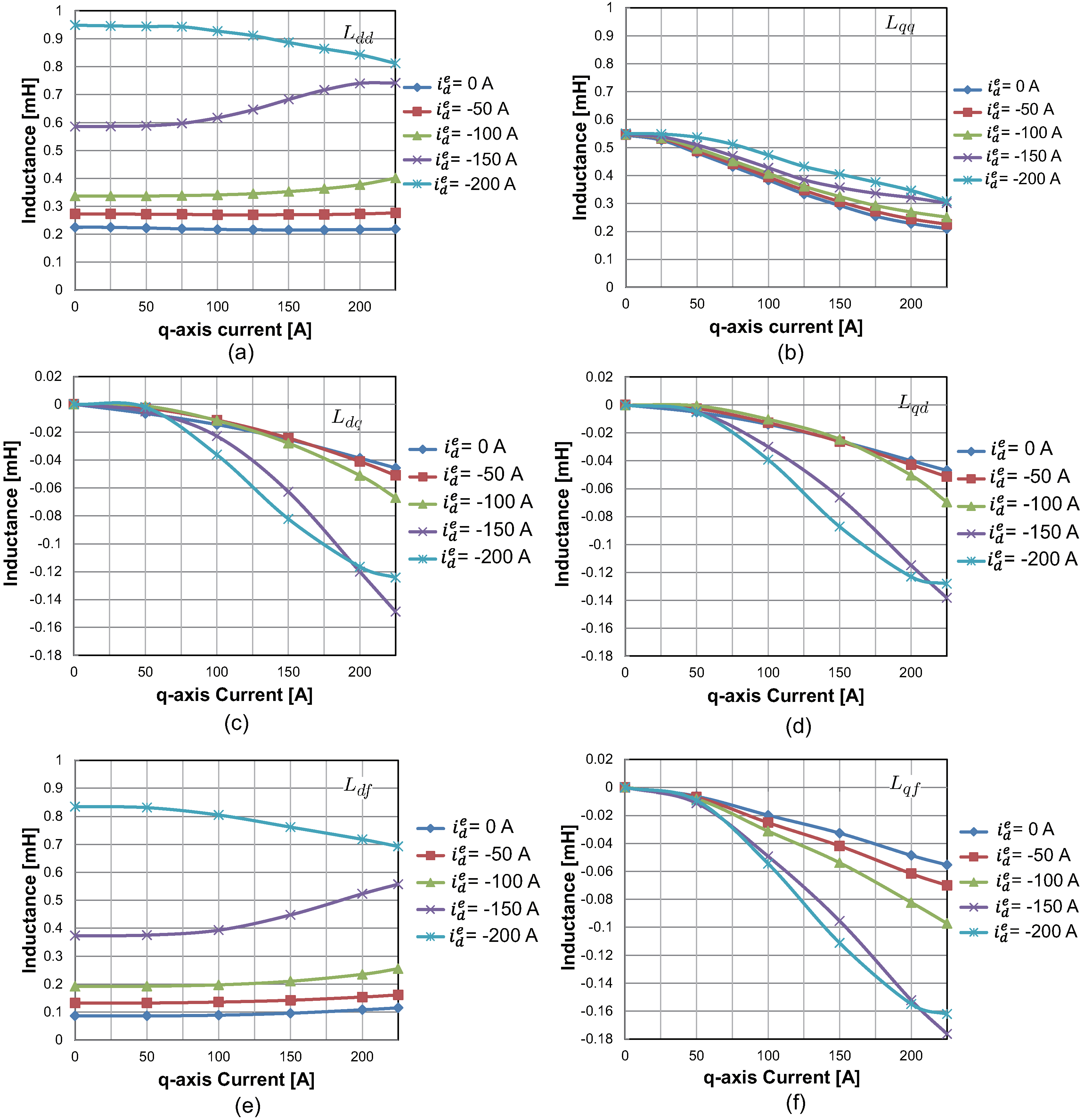
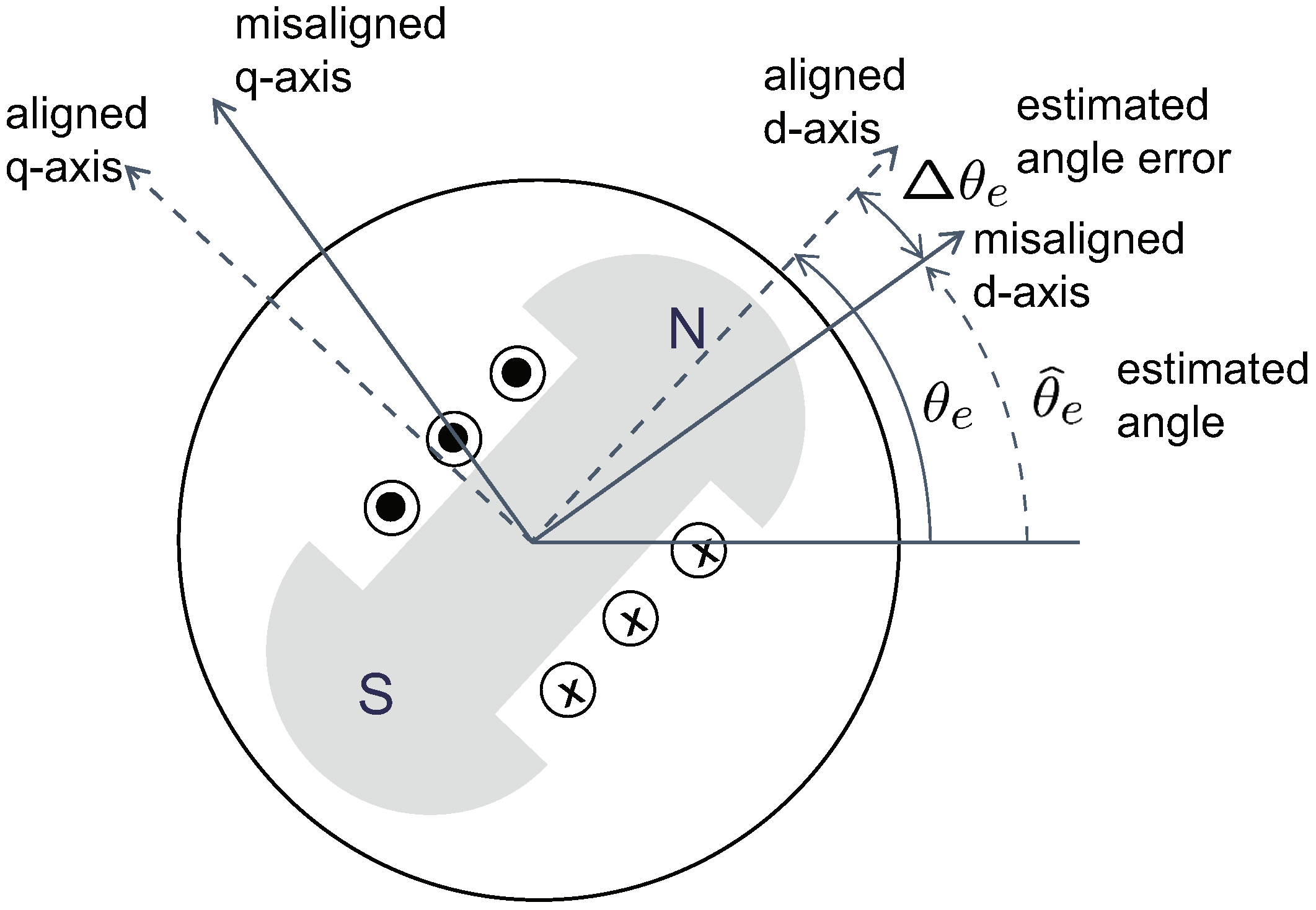

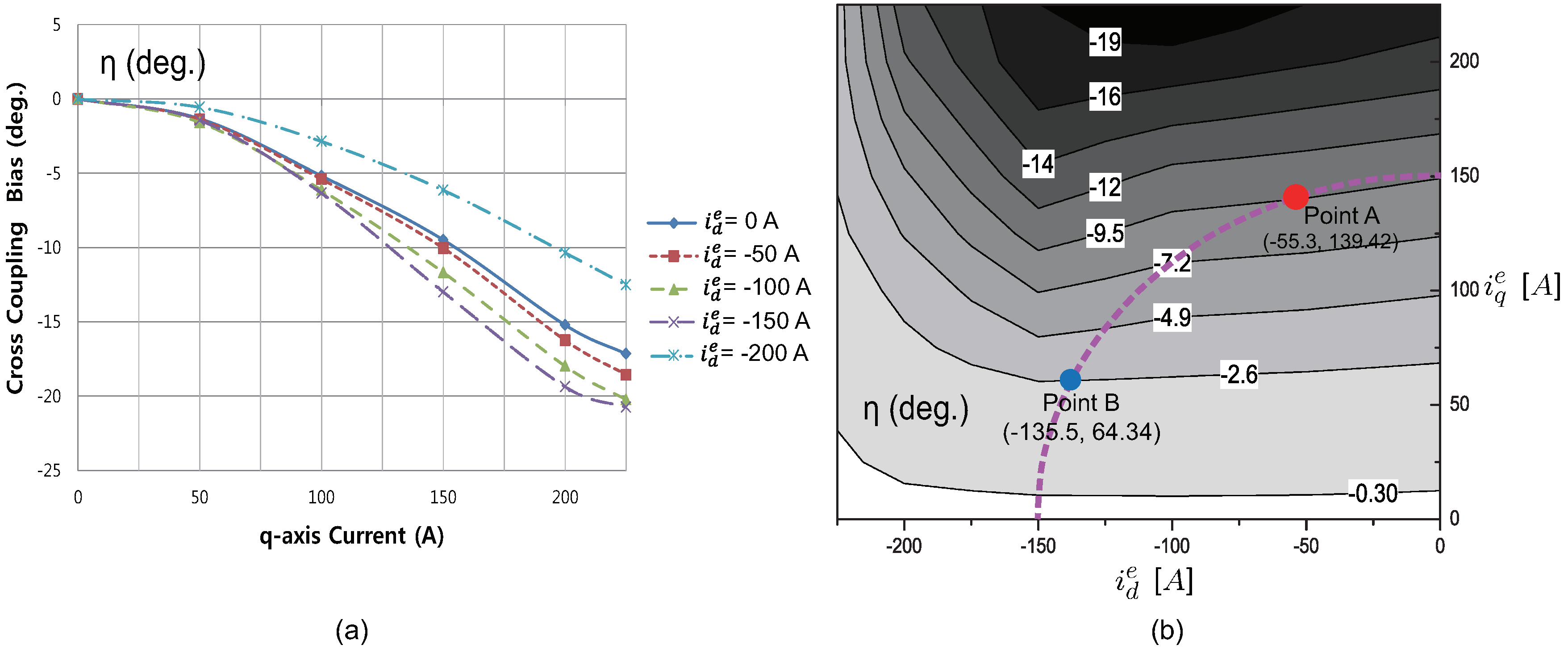
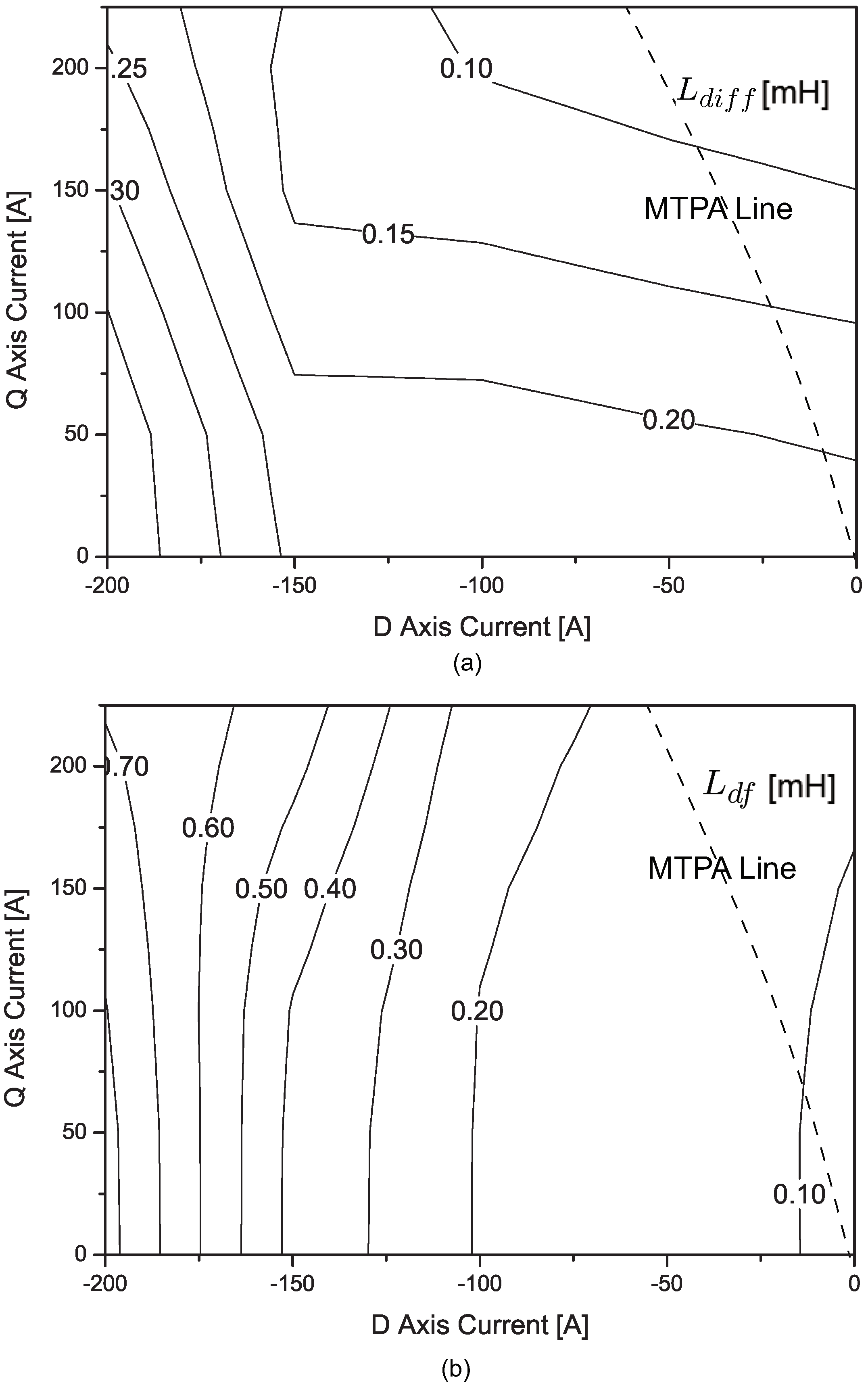
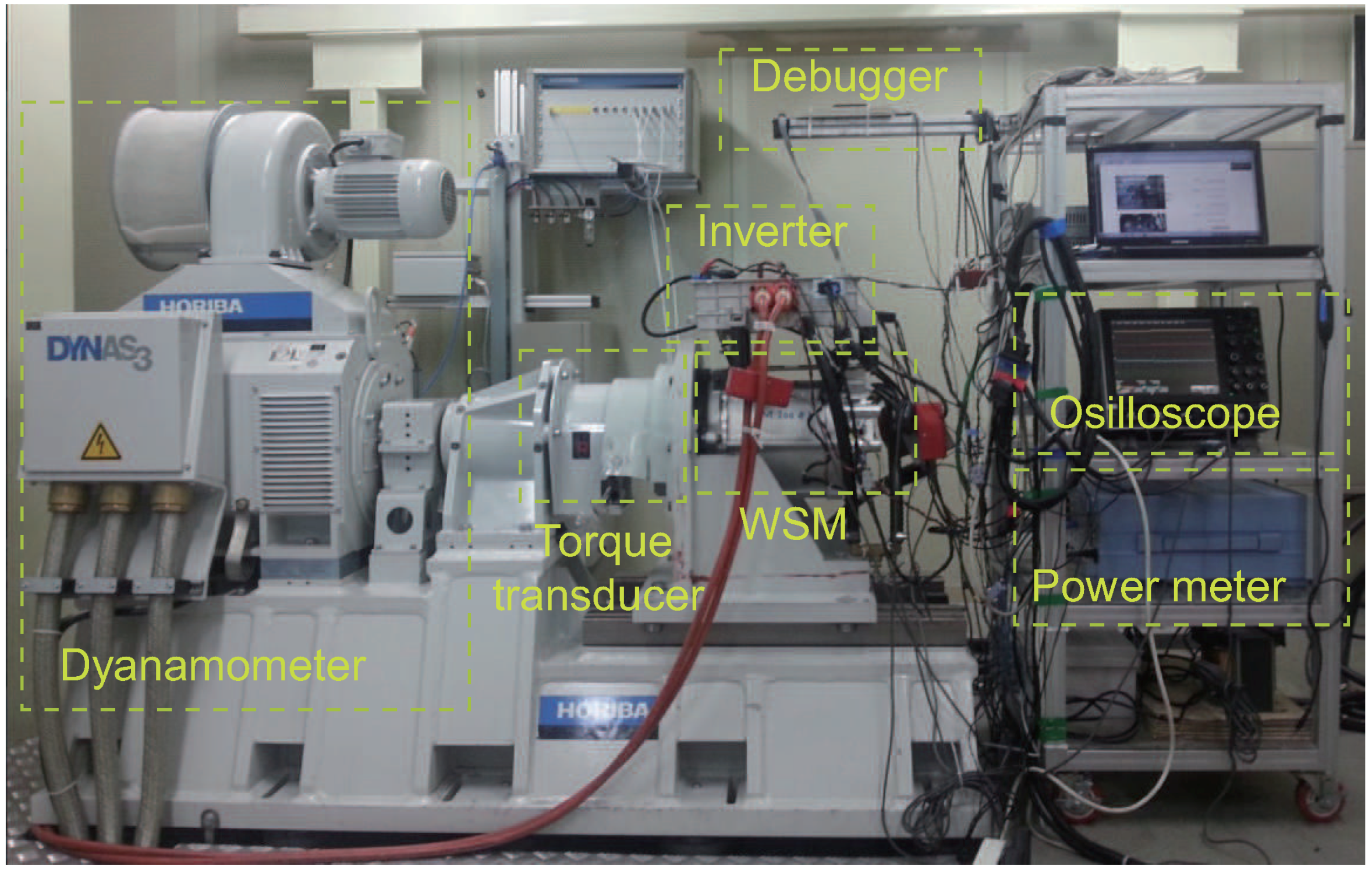

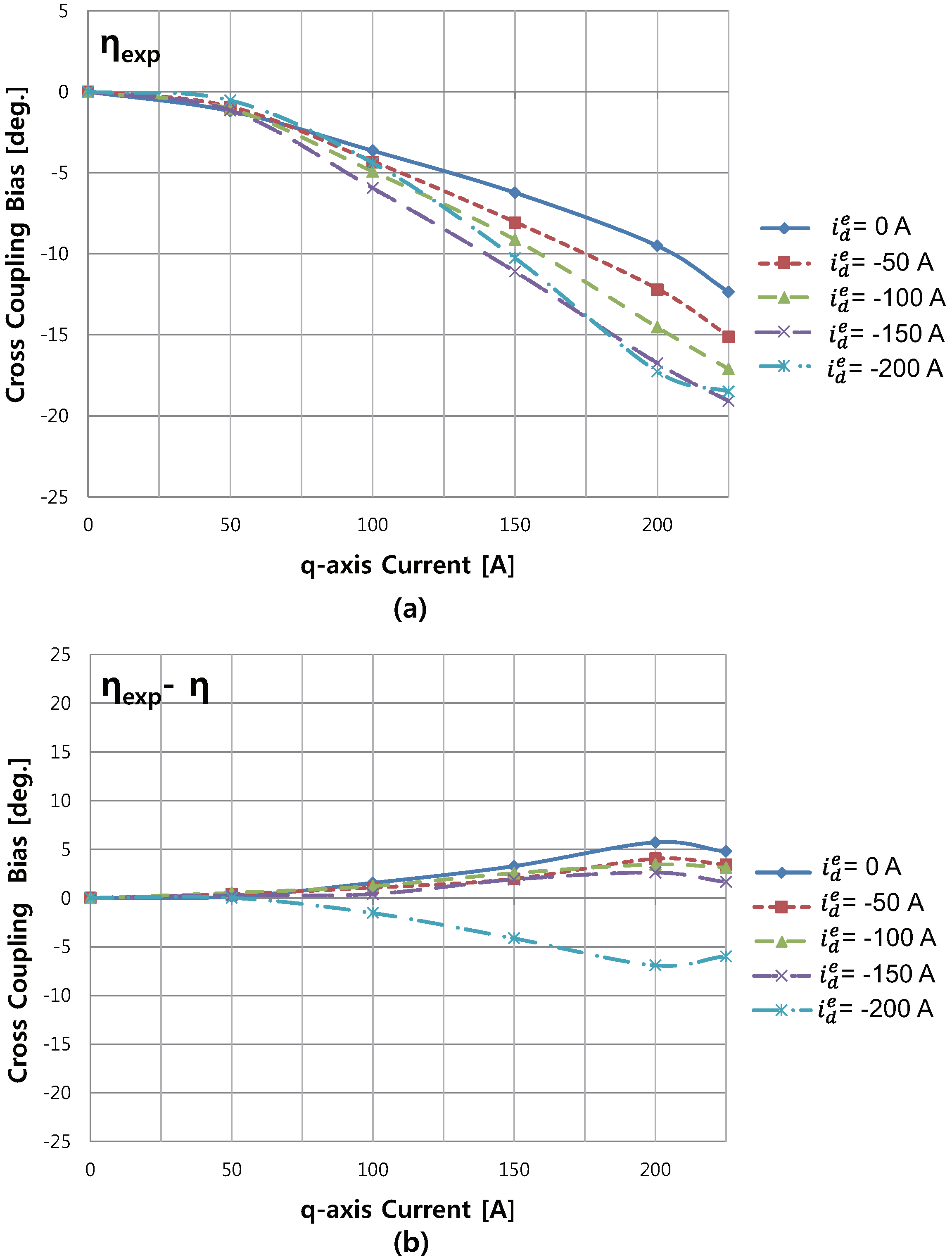
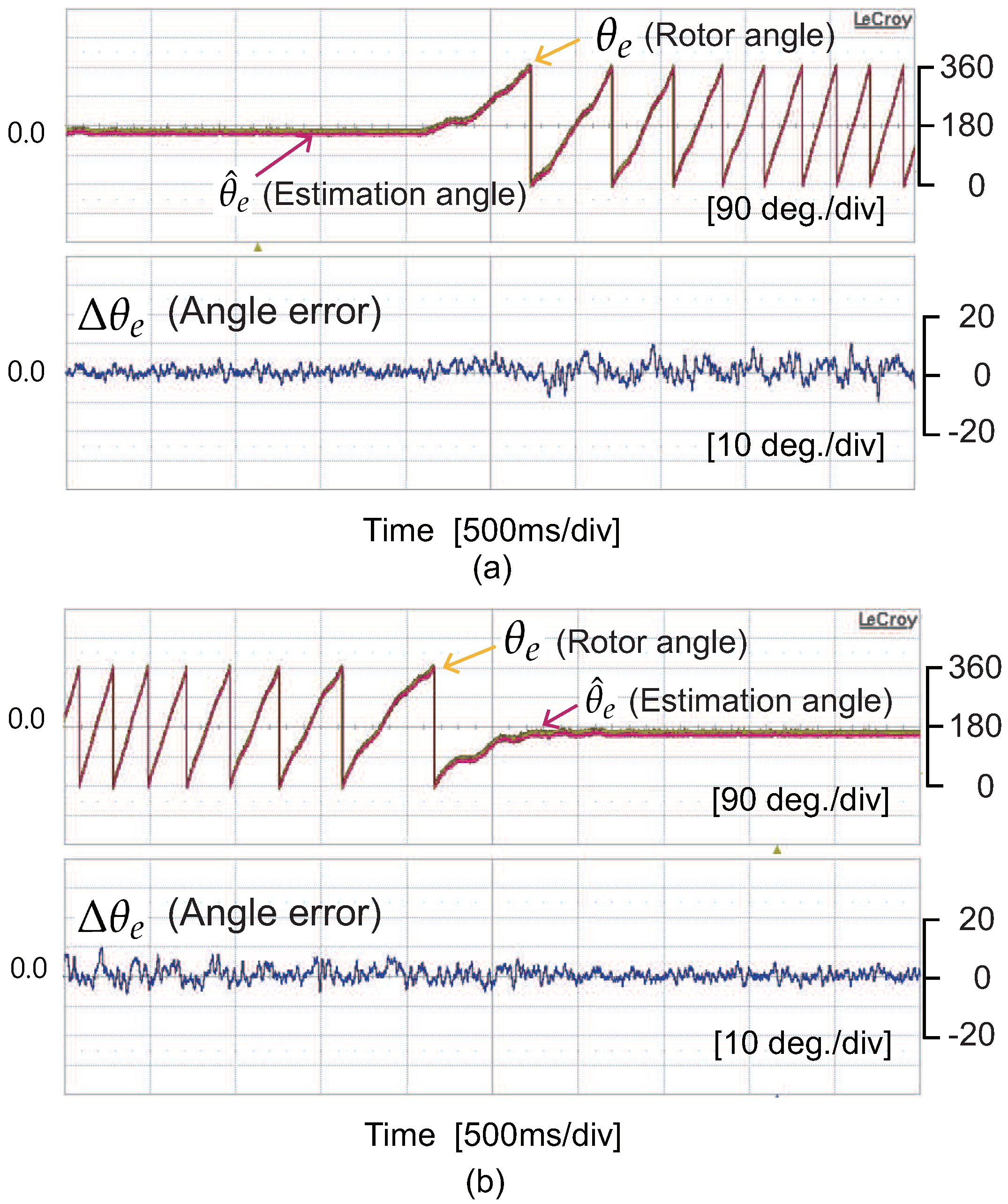
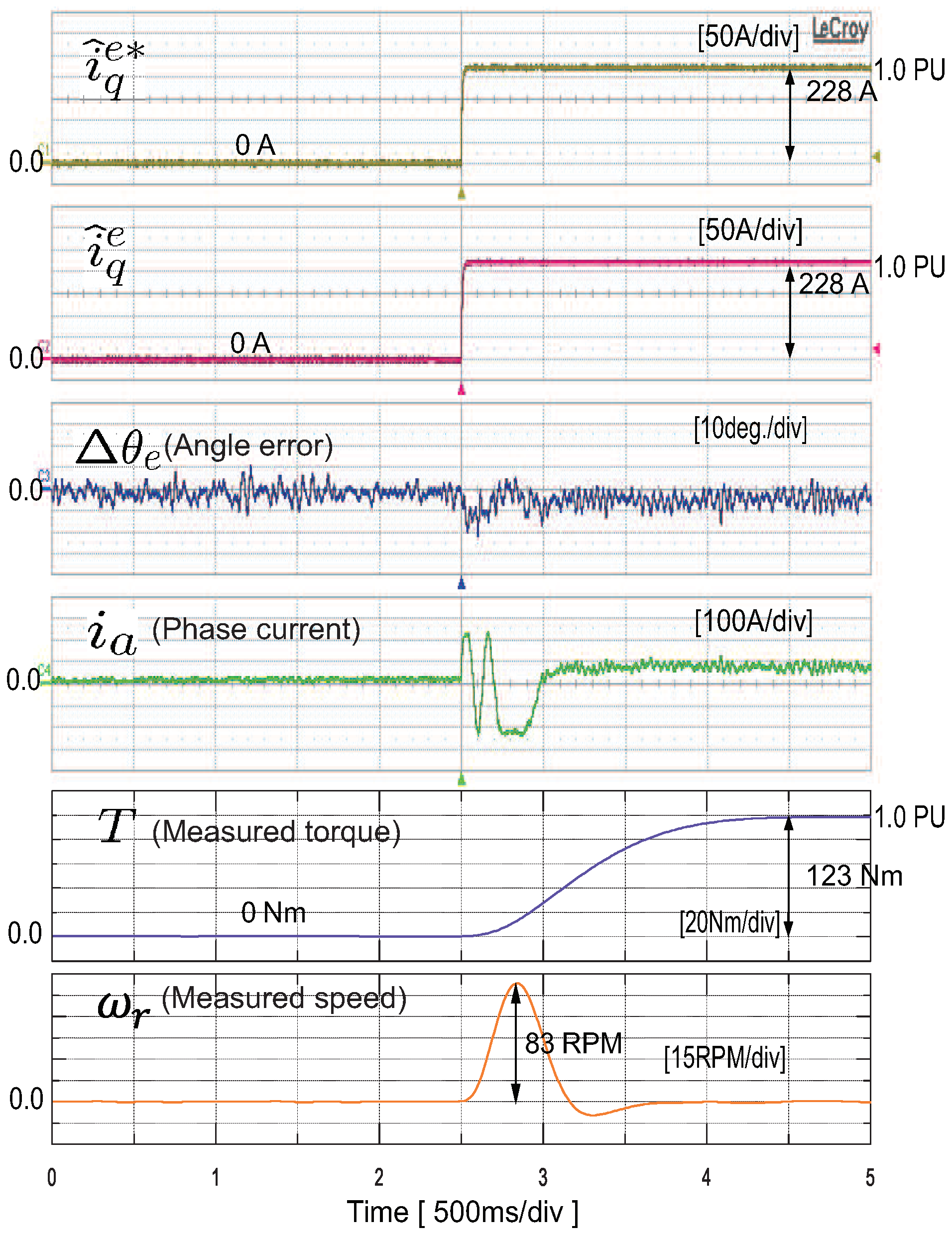
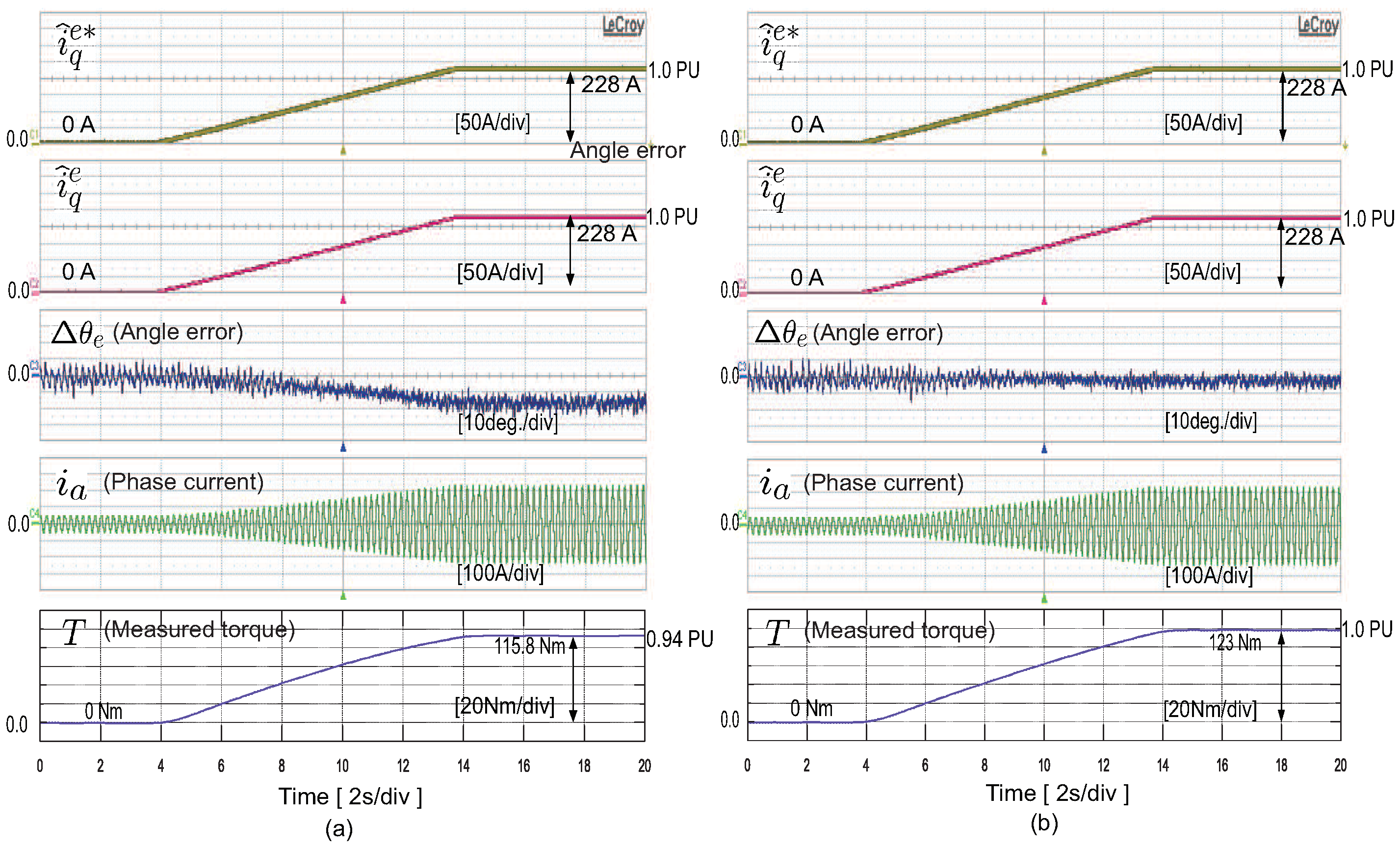
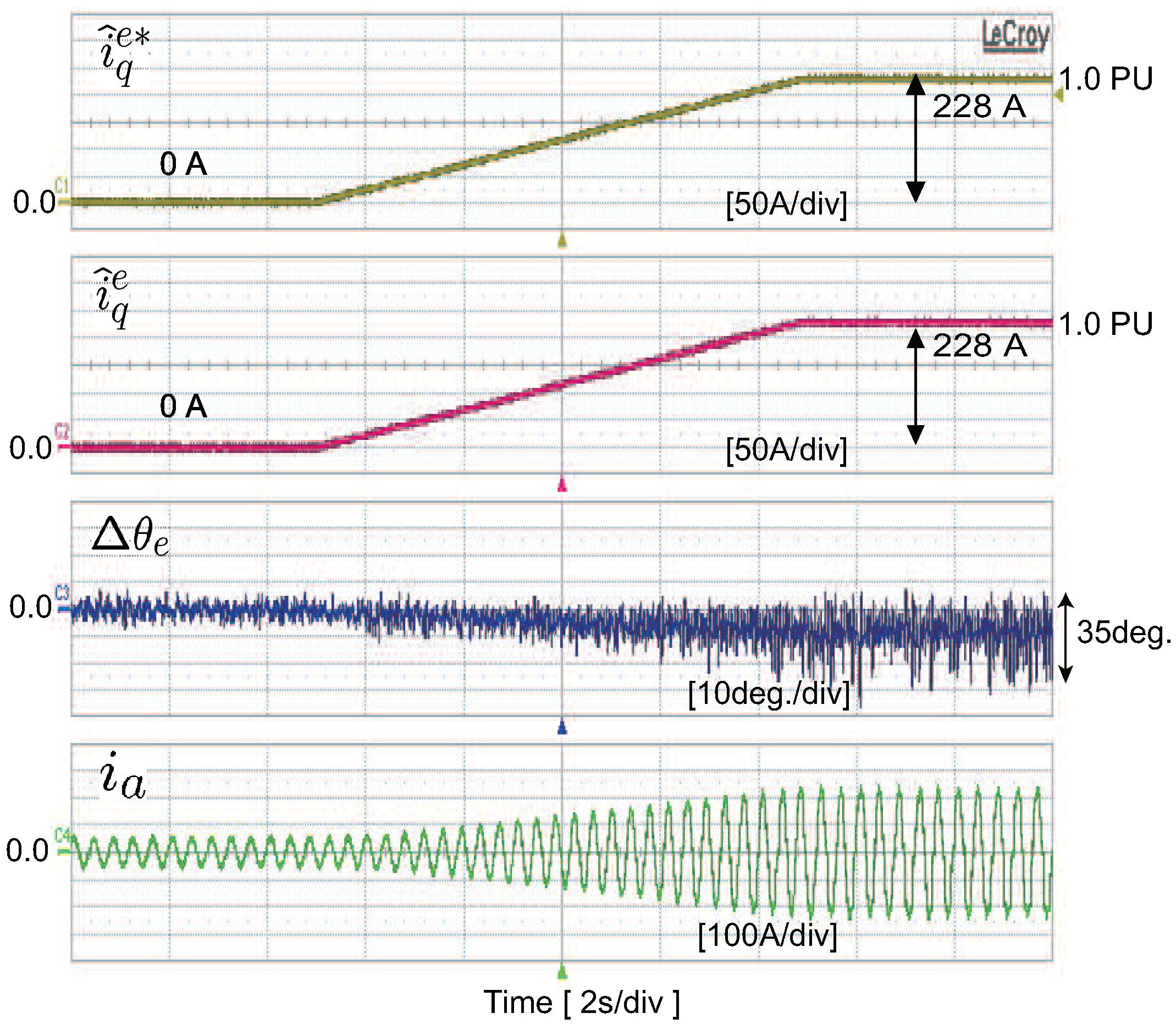
| Parameter | Value |
|---|---|
| Maximum power | 65 kW |
| Maximum torque | 123 Nm |
| Maximum current | 161 Arms |
| Numbers of poles (P) | 6 poles |
| Number of slots | 36 slot |
| Back-EMF coefficient | 0.121 Wb |
| Maximum speed | 12,000 r/min |
| Field current () | 6 A |
| Number of stator coil turns () | 3 turns |
| Number of field coil turns () | 200 turns |
| Signal Injection into Stator Winding | Signal Injection into Field Winding | |
|---|---|---|
| Signal amplitude | (Saliency) | (Mutual) |
| Polarity check | Necessary | Not necessary |
| SNR under core saturation | Small | Large |
| Signal generation | Inverter | dc-dc converter |
| Stable region () | < | < |
| Implementation | Easy | Medium difficulty |
© 2018 by the authors. Licensee MDPI, Basel, Switzerland. This article is an open access article distributed under the terms and conditions of the Creative Commons Attribution (CC BY) license (http://creativecommons.org/licenses/by/4.0/).
Share and Cite
Choi, J.; Nam, K. Wound Synchronous Machine Sensorless Control Based on Signal Injection into the Rotor Winding. Energies 2018, 11, 3278. https://doi.org/10.3390/en11123278
Choi J, Nam K. Wound Synchronous Machine Sensorless Control Based on Signal Injection into the Rotor Winding. Energies. 2018; 11(12):3278. https://doi.org/10.3390/en11123278
Chicago/Turabian StyleChoi, Jongwon, and Kwanghee Nam. 2018. "Wound Synchronous Machine Sensorless Control Based on Signal Injection into the Rotor Winding" Energies 11, no. 12: 3278. https://doi.org/10.3390/en11123278
APA StyleChoi, J., & Nam, K. (2018). Wound Synchronous Machine Sensorless Control Based on Signal Injection into the Rotor Winding. Energies, 11(12), 3278. https://doi.org/10.3390/en11123278




